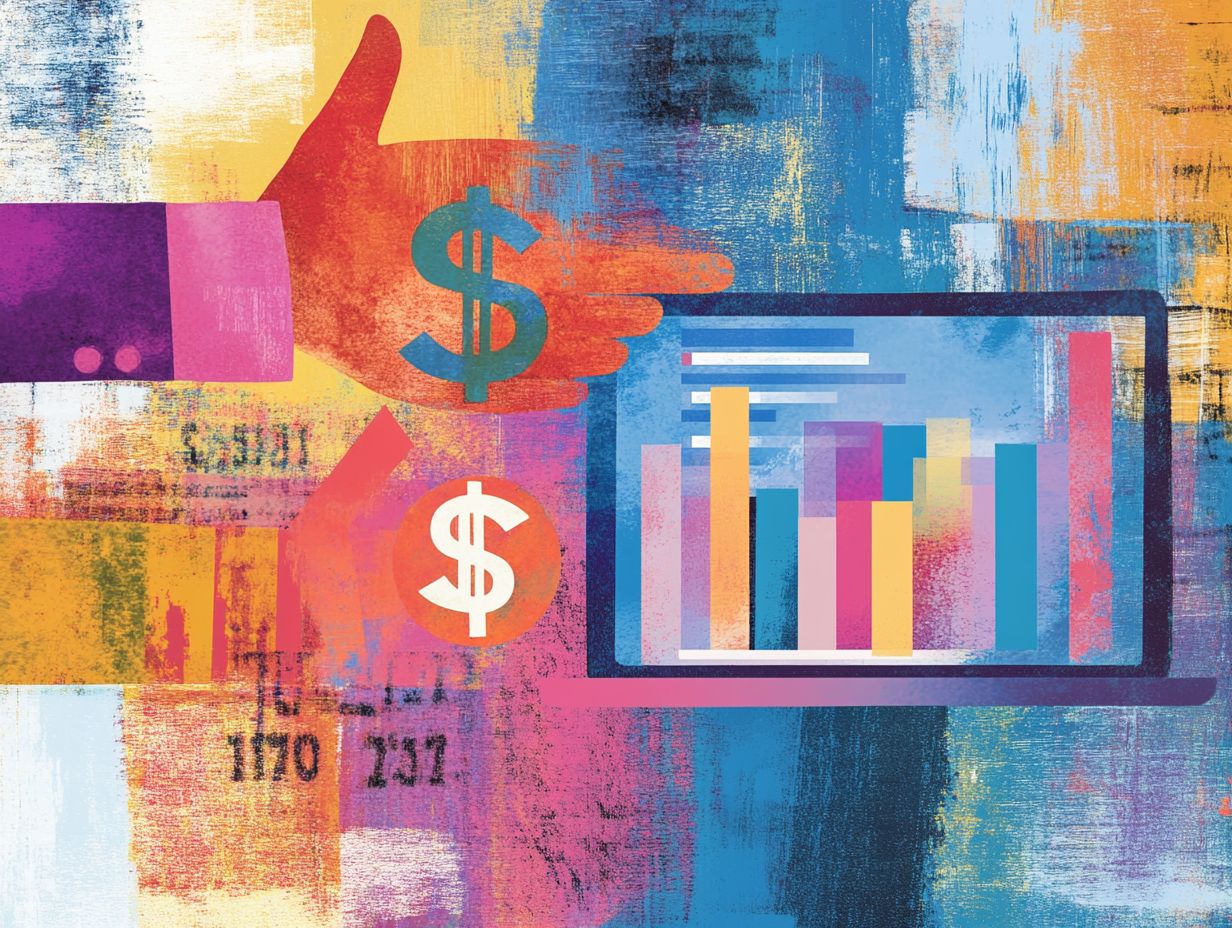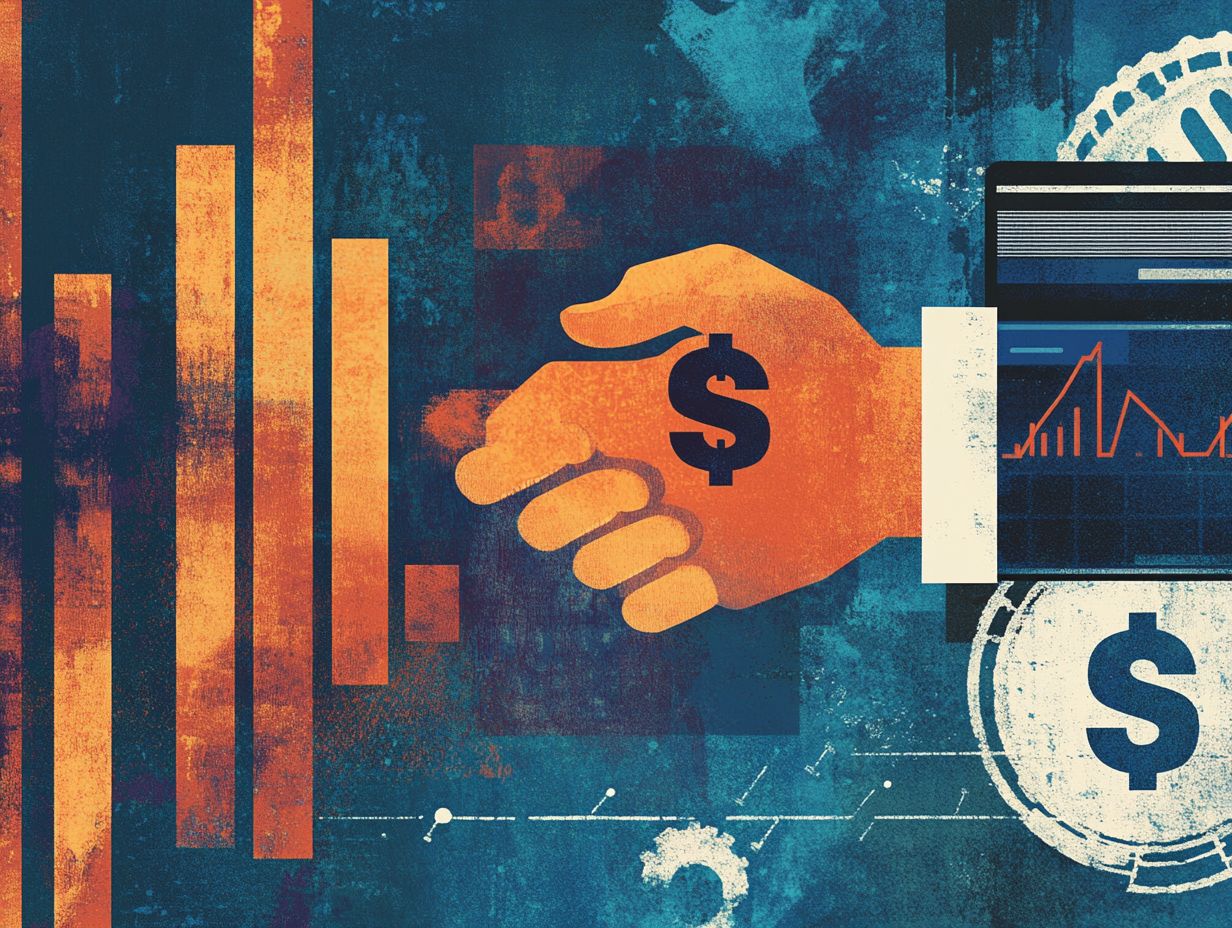Top 10 FAQs About Peer-to-Peer Lending
Peer-to-peer lending is transforming the financial landscape. It presents an enticing alternative to traditional banking systems. This innovative approach connects you directly with individual investors, crafting a lively marketplace for loans.
Are you curious about how it all works? What benefits or risks come with it? This guide answers the top 10 frequently asked questions about peer-to-peer lending, exploring everything from the mechanics of borrowing and investing to the regulatory landscape.
Whether you re considering borrowing or investing, this article equips you with essential insights to confidently navigate the world of P2P lending.
Contents
- Key Takeaways:
- 1. What Is Peer-to-Peer Lending?
- 2. How Does Peer-to-Peer Lending Work?
- 3. What Are the Benefits of Peer-to-Peer Lending?
- 4. What Are the Risks of Peer-to-Peer Lending?
- 5. How Do I Get Started with Peer-to-Peer Lending?
- 6. How Much Can I Borrow through Peer-to-Peer Lending?
- 7. What Are the Interest Rates for Peer-to-Peer Lending?
- 8. How Are Payments Made in Peer-to-Peer Lending?
- 9. What Happens If a Borrower Defaults on a Loan?
- 10. Is Peer-to-Peer Lending Regulated?
- How Does Peer-to-Peer Lending Compare to Traditional Lending?
- What Are the Different Types of Peer-to-Peer Lending?
- What Are the Qualifications for Borrowers in Peer-to-Peer Lending?
- How Can Investors Mitigate Risks in Peer-to-Peer Lending?
- Understanding Your Tax Responsibilities in Peer-to-Peer Lending!
- How Can Borrowers Improve Their Chances of Getting Approved for a Loan?
- Frequently Asked Questions
Key Takeaways:
- Direct Connection: Peer-to-Peer Lending links borrowers with investors, skipping banks.
- Lower Costs: Enjoy lower interest rates and flexible options.
- Be Cautious: Understand risks like default rates and limited regulations.

1. What Is Peer-to-Peer Lending?
Peer-to-Peer (P2P) lending presents an innovative financial model that connects you directly with lenders. This allows you to bypass traditional banks and access funds more easily. Meanwhile, investors find new opportunities for generating capital and enjoying competitive returns.
P2P lending platforms serve as intermediaries, creating a dynamic marketplace for users. Forget about rigid protocols and hefty fees; these platforms simplify the borrowing process, making it more accessible for individuals and small businesses.
You have a range of popular options at your disposal, including:
- Funding Circle
- Kiva
- LendingClub
- Prosper
- Upstart
Each option is tailored to meet various borrower needs, whether for small business financing or personal loans. Your creditworthiness, or your ability to repay a loan, is crucial in this space, as it influences interest rates and borrowing limits. This allows investors to evaluate the risk before committing their funds.
P2P lending platforms harness technology to analyze credit scores, providing a more democratized approach. This makes lending accessible to many who might otherwise be overlooked by traditional models.
2. How Does Peer-to-Peer Lending Work?
P2P lending unfolds through online platforms that link you directly with investors. You apply for loans while benefiting from an automated system designed to assess creditworthiness and oversee the entire lending journey.
When you submit your application, the platform uses advanced algorithms to conduct thorough risk assessments. It looks into your credit scores, financial history, and other important data. This evaluation is crucial for determining your loan eligibility and the interest rates you’ll encounter.
Once your application receives approval, it gets listed on the marketplace. Investors review it, choose to fund your loan, and establish the terms. The platform then facilitates the transaction, ensuring secure fund transfers.
Throughout your loan term, technology manages repayments, tracks payment schedules, and provides real-time updates to both you and the investors. This effectively streamlines the entire process from application to closure.
3. What Are the Benefits of Peer-to-Peer Lending?
P2P lending offers a wealth of advantages, providing alternative financing options with lower interest rates than traditional loans. For investors, this means enjoying attractive returns through monthly loan payments and a chance to diversify investments.
This approach streamlines access for borrowers, enabling quick fund acquisition without the usual bureaucracy of conventional banking. If you re looking to invest, platforms allow you to secure competitive interest rates, often leading to higher returns than traditional savings accounts or investments.
You can spread your capital across various loans, minimizing risk while enhancing your portfolio’s overall stability. This unique model creates a win-win situation: lenders enjoy favorable returns, while borrowers gain access to affordable and accessible financing solutions.
Ready to dive into the world of Peer-to-Peer lending? Start today and unlock your financial potential!
4. What Are the Risks of Peer-to-Peer Lending?
P2P lending offers intriguing opportunities, but it is important to understand the risks involved. These risks include the chance that a borrower might not pay back the loan, issues related to the operational integrity of the platform, and the need for effective risk management strategies.
As an investor, you may face uncertainties due to the different creditworthiness of borrowers, which can impact repayment rates. Platform risk includes potential cybersecurity threats or management failures that could affect your investments.
For borrowers, high-interest rates linked to poor credit ratings can create financial strain. To navigate these challenges, make sure to carefully check borrowers credit histories and adopt strong risk management practices.
By evaluating borrowers’ credit histories, income stability, and existing debts, you can gain valuable insights into their likelihood of meeting loan obligations, ultimately reducing potential losses.
5. How Do I Get Started with Peer-to-Peer Lending?
To start your P2P lending experience, choose a reputable lending platform and create an investor account. Then, evaluate various loan offers that match your financial goals.
Before diving into the investment process, familiarize yourself with the different types of loans available, such as personal loans, small business loans, and student loans. Each type comes with its own unique risks and returns, and understanding these will help you make informed choices.
Whether you’re looking for funding as a borrower or aiming for returns as an investor, follow these steps:
- Conduct thorough due diligence on potential borrowers.
- Diversify your investments across multiple loans to reduce risk.
- Continuously monitor the performance of your investments.
This holistic approach deepens your understanding and maximizes your potential for success in P2P lending.
6. How Much Can I Borrow through Peer-to-Peer Lending?

The amount you can borrow through P2P lending varies significantly based on factors such as your financial profile, creditworthiness, and the policies of the lending platform you choose.
For example, different platforms may set borrowing limits based on your income level. If you have a stable, higher income, you might qualify for amounts exceeding $50,000. On the other hand, if your income is lower, your borrowing options could be capped at around $15,000.
Your credit score is crucial as well; a score above 700 typically grants you access to better terms and higher limits, while scores below 600 could lead to significant restrictions.
Additionally, the type of loan you seek whether personal, business, or student can greatly affect the borrowing range available to you. For instance, a personal loan might allow you to borrow up to $35,000, while a small business loan on the same platform could exceed $100,000.
This highlights the diverse borrowing opportunities within the P2P lending landscape.
7. What Are the Interest Rates for Peer-to-Peer Lending?
Interest rates for P2P lending can vary widely, ranging from low rates to more elevated ones, depending on your creditworthiness and market conditions.
It is essential to compare rates across various lending platforms to find the best deal. These rates are influenced by multiple factors, including the overall economic environment and each platform’s lending policies.
Your credit score plays a significant role in determining your interest rate, reflecting your ability to manage debt responsibly. For instance, if you have a strong credit history, you might secure a rate as low as 5% on a platform like LendingClub.
However, if your credit score is not as strong, you could encounter rates exceeding 20% on similar platforms. When comparing these rates with traditional lenders, which usually offer rates between 3% to 15%, it becomes evident that the choice of lending platform can significantly affect your borrowing costs.
8. How Are Payments Made in Peer-to-Peer Lending?
In Peer-to-Peer lending, you will likely see payments structured as monthly installments that encompass both principal and interest. This arrangement ensures that you receive timely repayments.
Borrowers can effectively manage their financial commitments with this predictable schedule. They can budget their expenses with greater ease, anticipating their payment dates and amounts each month.
A variety of payment methods are available, from bank transfers to automated debit options, allowing borrowers the convenience they need to meet their obligations.
However, it’s crucial to be aware of the consequences of late payments or defaults. Borrowers may face additional penalties, heightened interest rates, or even damage to their credit scores, which could impede their ability to obtain future loans.
For investors, delays in receiving returns can disrupt their overall investment strategy, underscoring the importance of timely payments.
9. What Happens If a Borrower Defaults on a Loan?
In the unfortunate event that a borrower defaults on a loan in Peer-to-Peer lending, the consequences can ripple through both their finances and the investors interests. This situation can lead to higher default rates, requiring lenders to manage risk effectively.
Establish clear protocols to handle defaults. These typically include recovery processes designed to reclaim lost funds through various strategies, such as negotiation or legal action.
For investors, a default could adversely impact their returns, diminishing their expected revenues and escalating portfolio risks. To avoid defaults, you should consider these steps:
- Maintaining open lines of communication with your lenders
- Choosing loan amounts that are more manageable for your situation
- Ensuring you have contingency plans ready in case financial setbacks arise
This various strategies can significantly help mitigate the detrimental effects of defaults for everyone involved.
10. Is Peer-to-Peer Lending Regulated?
Peer-to-peer lending operates under a set of regulations that differ by country and region, primarily designed to protect both borrowers and investors.
Often, these regulations necessitate the involvement of financial institutions to maintain compliance and uphold market integrity. These rules help create a balanced environment where risks are effectively managed, fostering trust among all participants.
Financial institutions are key players in this arena; they provide essential oversight and ensure adherence to legal standards. As you explore funding from various sources, you benefit from increased access to capital, while investors discover alternative investment opportunities.
This dynamic comes with challenges. Both borrowers and investors must navigate the complexities of compliance to protect their interests, ensuring a sustainable peer-to-peer lending ecosystem that effectively mitigates risks.
How Does Peer-to-Peer Lending Compare to Traditional Lending?
Peer-to-peer lending offers you a compelling alternative to traditional lending, allowing you to access funds often at lower interest rates while giving investors a more personal connection to their lending activities.
Unlike conventional banks that adhere to rigid protocols and lengthy approval processes, P2P platforms streamline applications, granting you quicker access to the financing you need.
This efficiency helps you sidestep the frustrations commonly tied to traditional loans, where credit scores and collateral can often serve as roadblocks.
Additionally, P2P lending typically provides greater transparency regarding fees and associated risks, fostering a sense of trust and understanding in your borrowing journey.
As a result, when seeking funds, you may find yourself engaging in not just a transaction but a personal relationship with your lenders, enriching your overall financial experience.
What Are the Different Types of Peer-to-Peer Lending?

Peer-to-Peer lending offers a variety of options, including personal loans, auto loans, and home improvement loans. Each type is designed to cater to your specific borrowing needs, whether you re a consumer or a small business owner.
Personal loans are especially popular for consolidating debt or covering unexpected medical expenses. Imagine freeing yourself from debt! These loans often provide more flexibility and better interest rates compared to traditional banks.
If you re in the market for a vehicle, auto loans are tailored just for that. They typically present competitive rates and terms that can make your purchase more manageable.
Homeowners looking to enhance their properties can benefit from home improvement loans. These loans provide funding for renovations or repairs, potentially boosting your property’s value in the long run.
Platforms like LendingClub and Prosper are trusted names in personal lending. For auto financing, consider LendingPoint and Upstart, while SoFi shines in home improvement loans.
Each of these loan types aims to provide accessible funding options, making your financial journey smoother and more efficient.
What Are the Qualifications for Borrowers in Peer-to-Peer Lending?
If you want to enter the world of Peer-to-Peer lending, you ll need to meet certain requirements that showcase your ability to repay, stable income, and the specific borrower criteria outlined by the lending platforms.
These requirements generally include a minimum credit score that varies from one platform to another. Higher scores often unlock better loan terms.
As a potential borrower, you typically need to provide thorough income documentation, such as pay stubs or tax returns, to demonstrate your financial stability. This verification process allows lending platforms to assess risk and tailor loan offers to suit you.
If you have a solid credit history and consistent income streams, you can expect lower interest rates and more flexible repayment options, enhancing your lending experience.
How Can Investors Mitigate Risks in Peer-to-Peer Lending?
As an investor in Peer-to-Peer lending, you can adopt several strategies to reduce risks. Diversifying your investments across different loans, implementing thorough risk management practices, and carefully selecting your investment opportunities are effective methods.
By spreading your investments across a range of loans, you decrease the likelihood of suffering significant losses from defaults on any single loan. This strategy enhances the overall stability of your portfolio and allows you to tap into various borrower profiles, reducing your risk exposure.
Analyzing borrowers’ financial profiles can provide crucial insights into their repayment capabilities, enabling you to make informed decisions. By implementing these strategies, you can cultivate a more resilient investment approach, potentially yielding favorable returns while protecting yourself against market fluctuations.
Understanding Your Tax Responsibilities in Peer-to-Peer Lending!
The tax implications of Peer-to-Peer lending can vary significantly, affecting you as both a borrower and an investor. Pay attention to income taxation on interest earned and any potential deductions for specific loan-related expenses.
As an investor, the money you receive from lending out your funds is generally considered taxable income. You ll need to report it on your annual tax returns, which could influence your overall tax liabilities.
If you’re a borrower, there might be some tax benefits depending on how you use the loan proceeds. For instance, you could be eligible for deductions on points paid or interest accrued if the funds are used for qualifying purposes.
By understanding these nuances, you can make more informed financial decisions. Ensure you grasp the full scope of your obligations and entitlements in the world of Peer-to-Peer lending.
Explore Peer-to-Peer lending options further or consider consulting a financial advisor to maximize your opportunities!
How Can Borrowers Improve Their Chances of Getting Approved for a Loan?
To improve your chances of securing a loan, focus on your creditworthiness. Understand borrower requirements and present a strong financial profile to potential investors.
Taking actionable steps can make a significant difference. First, regularly check your credit scores and promptly address any errors. This can lead to an increase in your overall ratings.
Gather thorough documentation like income statements and tax returns. This creates a clear financial picture for investors.
Being transparent about your specific financial needs and demonstrating a clear repayment plan can foster trust. By combining these strategies, you can boost your credibility and appeal more effectively to potential lenders in the competitive landscape of peer-to-peer lending.
Frequently Asked Questions
1. What is peer-to-peer lending?

Peer-to-peer lending, or P2P lending, connects borrowers directly with investors through an online platform. It eliminates the need for traditional financial institutions like banks, allowing individuals to borrow and lend money to one another.
2. How does peer-to-peer lending work?
On a peer-to-peer lending platform, borrowers create a loan listing detailing the amount they need and the purpose of the loan. Investors review these listings and choose which loans to fund. For a deeper insight, you can explore understanding the peer-to-peer lending process. Once enough investors contribute to the loan, the borrower receives the funds and begins making monthly repayments to the investors.
3. Is peer-to-peer lending safe?
Peer-to-peer lending platforms typically have measures to protect both borrowers and investors. These can include credit checks, identity verification, and risk assessment algorithms. However, like any investment, there’s always a level of risk, so carefully consider the platform and the loans before investing.
4. What are the benefits of peer-to-peer lending?
Peer-to-peer lending often provides better returns than traditional savings accounts. It also offers borrowers an alternative to traditional bank loans, often with lower interest rates and more flexible terms.
5. How much can I borrow through peer-to-peer lending?
The amount you can borrow varies depending on the platform and your creditworthiness. Some platforms have a maximum loan amount, while others do not. Generally, borrowers can borrow from a few thousand dollars to hundreds of thousands through peer-to-peer lending.
6. How do I choose the right peer-to-peer lending platform?
When choosing a peer-to-peer lending platform, consider factors like interest rates, fees, borrower eligibility requirements, and the platform’s track record. Don’t miss out on reading reviews to find the best platform for you!






